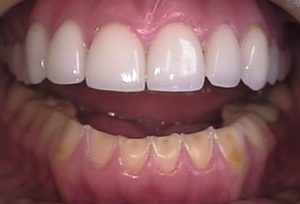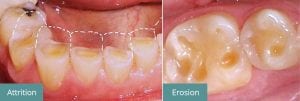
Do you know if your teeth have become worn over time? Dentists treat worn teeth on a daily basis, yet people are generally entirely unaware that teeth wear down, until their dentists alert them to signs of tooth wear.
After tooth decay and gum disease, tooth wear can be considered the third most significant dental issue. Worn teeth result not only in the cosmetic shortening of teeth, with implications on one’s bite, tooth sensitivity, gum recession, breaking and chipping of teeth.
How Do Teeth Get Worn Down?
Teeth can become worn over time though normal function, such as eating and speaking. Diets also contribute to the promotion of tooth wear at varying rates. In addition to normal tooth wear, other causes of tooth wear include:
Attrition
The most common cause of teeth wear is caused by repeated tooth-to-tooth contact from clenching or grinding, whereby the upper and lower teeth, touch or rub against each other at times other than when eating or swallowing. This type of tooth wear is called “attrition”.
Clenching and grinding can happen during the day unconsciously, such as when concentrating or when stressed. At night time, this unconscious grinding of teeth known as ‘bruxism’, most commonly occurs at night whilst asleep, hence many people are unaware of the habit to control it. Bruxism results in tooth damage and contributes to the accelerated loss of tooth height.
Please click here for further information on bruxism.
Abrasion
Tooth enamel can be “abraded” away by foreign objects. Common examples of tooth abrasion include:
- The use of medium or hard bristle brushes and particularly abrasive toothpastes can accelerate enamel loss.
- Oral jewellery, such as lip and tongue piercings often wear away or cause the fracture of adjacent teeth.
- Habits such as biting of fingernails, chewing or holding hard objects, such as pens or ice cube between the teeth.
Erosion
This is the chemical wear of tooth enamel. The acid involved in this process can come from a number of sources, such as:
- Acidic substances like soda, energy drinks, juice, coffee or from acid reflux
- Citrus foods: lemons, limes, oranges, grapefruits and some candies (in particular sour candies) contain citric acid
- Most soft drinks, sports drinks and fruit juices are very acidic
- Coffee and tea contain corrosive acids
- Red and white wine are highly acidic
- Individuals who suffer from gastric reflux regularly expose their teeth to harsh stomach acids
- Chronic dehydration, reduced salivary gland function and some medications can all cause a dry mouth. The minimal saliva that remains often is rather
What Do Worn Teeth Look Like?
Mild tooth wear is difficult to detect as it isn’t always visibly obvious.
Severe tooth wear is generally much more apparent, and can be painful. Teeth with severe wear appear shorter, flatter-looking with sharper edges and more yellow, as the inner layers of the tooth become exposed.
With severe tooth wear, the ends of teeth can easily become chipped, hence giving a jagged appearance. In other cases, the teeth can look more rounded along the ends as though it is smoothed down.

The Five Most Common Signs of Teeth Wear
Worn teeth can often cause soreness and tightness in the facial muscles.
In addition, the five most common signs of teeth wear are:
- Teeth that look unusually jagged or smooth
- Cracks or chips in teeth
- Shorter teeth
- Tooth sensitivity or pain (especially with hot or cold foods)
- Yellowing of teeth from worn enamel
What are the Health Implications and Consequences of Worn Teeth over time?
Increased risk of decay
Worn teeth are more vulnerable to cavities and decay. With teeth wear, some of the hard protective outer layer, called tooth enamel is missing, so it’s no longer there to prevent bacteria from invading the tooth and hence making the tooth more susceptible to decay.
Uneven bite
When teeth lose their natural shape, the bite can change. As all our teeth work together as part of one dental system, as one tooth becomes worn, so will others over time affecting how they align with each other and hence affecting the bite. This all sets off a vicious cycle, as a bad bite can lead to more grinding and clenching while you sleep, which only creates more teeth wear and more damage over time. A bad bite not only affects dental health, but has been associated to other health implications such as jaw popping / temporomandibular disorders, headaches, facial and neck muscle pain, as well as sleep and behavioural complaints.
Facial changes
Teeth can become so badly worn that a significant portion of the tooth becomes missing, hence shortening the height of the bite; thus making the lower half of one’s face appear shorter.
Dental Solutions and Dental Treatments for Worn Teeth
If you or your family have worn teeth or are concerned about the possibility of having worn teeth, do take the first step by discussing any concerns with our expert family dentists at East Ringwood Dental Clinic.
Depending on the severity of the situation, there are a number of possible treatment options available to address worn teeth. The most appropriate solution for each client is individually assessed by the family dentists and is dependent on the initial cause that led to your teeth becoming worn in the first place and how severe the tooth wear currently is.
Dental Crowns and Other Restorations
If there is already significant amounts of tooth wear due to attrition (most commonly from grinding and clenching), dental treatment options can include replacing the lost tooth structure with dental restorations, such as porcelain crowns or composite veneers to cover and protect worn teeth, as well as rebuild the worn teeth back up to their former natural state. The level of complexity with such dental restorations will depend on the degree of tooth wear present.
Another factor our experienced dentists at East Ringwood Dental Clinic take into consideration is the rate of teeth wear that has occurred, as this can also impact on which dental treatment is the most appropriate.
Slow rate of wear
Teeth that wear down slowly will tend to maintain proper bite proportions by erupting slightly from the gums. In this manner, the gums will also shift downwards, leading to the appearance of short stout teeth. In such cases, orthodontic dental treatment to return the teeth to their original position is an appropriate dental solution.
Other options involve recontouring the gum line, especially when there are varying gum heights to provide the most aesthetic smile. Once the gums have been restored to a good position, the worn teeth can be treated with dental crowns or dental veneers.
Fast, aggressive wear
Sometimes the teeth wear down so rapidly, that the natural teeth cannot compensate for it. This results in the bite collapsing and shortening the facial distance between the chin and the nose. Such change in facial appearance can accentuate the aging features, causing sagging cheeks and deeper wrinkle lines around the mouth.
This reduced face height can be addressed by correcting the bite collapse. In such instances, all remaining teeth will have to be considered for restorative dental treatments to reopen the bite and balanced the functional forces on all teeth.
Can you afford to wait for treatment?
Unfortunately, if your teeth are worn now, they will continue to wear over time. With the best treatment, you will gain the benefits natural dental function as well as a smile makeover.
As with all medical conditions, treatment often begins with identifying and assessing the current situation. If you or your family has worn teeth or are at all concerned about the possibility of worn teeth, please call (03) 9870 8243 for the best expert advice with our experienced family dentists at East Ringwood Dental Clinic.
Image courtesy of Jeffrey Dorfman under Creative Commons Generic Licence CC BY-SA 3.0
